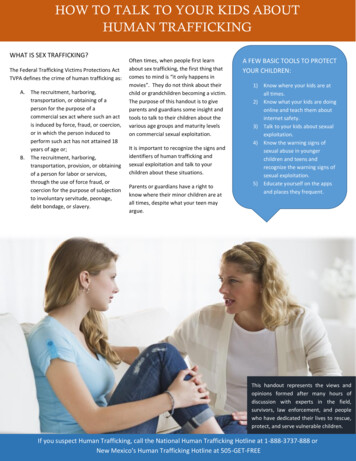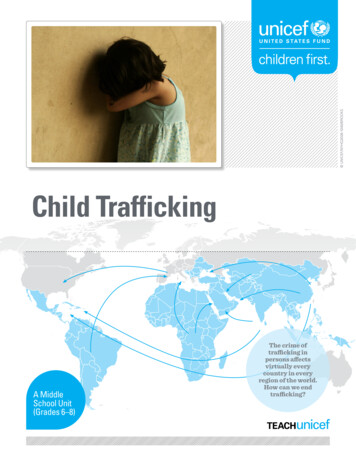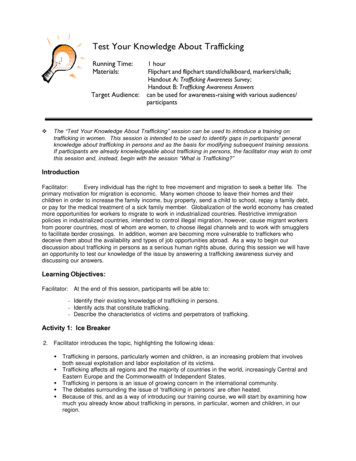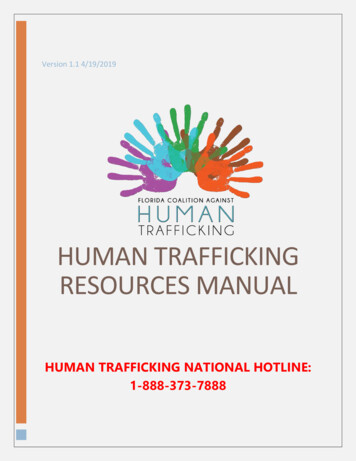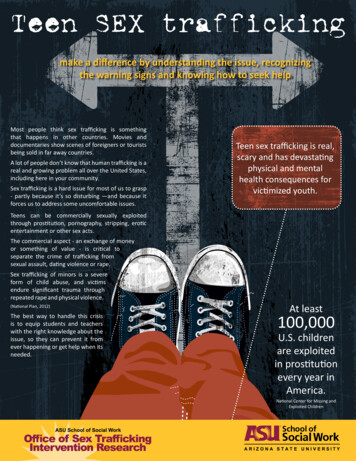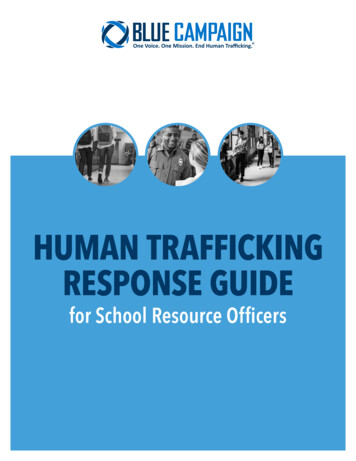
Transcription
HUMAN TRAFFICKINGRESPONSE GUIDEfor School Resource Officers
ABOUT THIS GUIDEAs a school resource officer (SRO), you are in a unique position to reach students considered vulnerable to exploitationand human trafficking. You play an important role because you may regularly interact with different students as part ofyour daily job duties, thus often building rapport amongst the student body and gaining their trust.You may be able to recognize signs that something is wrong in a student’s life. This guide seeks to inform SROsabout human trafficking and its indicators so you can be better prepared to recognize a potential victim at theschool you serve and know how to report a potential case. This guide includes information about:» What human trafficking is» How to recognize it among youth» Tips for talking to students about general exploitation» Building life skills that may help prevent youth from being trafficked» Reporting options if you suspect a student is affected by human trafficking or being exploited» Ensuring potential victims or impacted students get connected to appropriate service providers/supportservicesTherefore, once SROs become confident with these tools and how to implement them, schools and officers willbecome better equipped to effectively combat human trafficking.WHAT IS HUMAN TRAFFICKING?Human trafficking involves the use of force, fraud, or coercion to obtain some type oflabor or commercial sex act. Human traffickers use various forms of force, fraud, and coercionto control and exploit victims.1 These forms may include but are not limited to fraudulentemployment opportunities, false promises of love or a better life, psychological coercion (i.e.,threats of black mail), and violence or threats of violence.2 However, causing someone underthe age of 18 to engage in a commercial sex act, regardless of using force, fraud, or coercion ishuman trafficking under U.S. law.3The crime of human trafficking hinges on the exploitation of another person. Peopleoften mistakenly believe “human trafficking” implies victims must be moved from one placeto another to qualify as a victim. Human trafficking does not require transportation to beconsidered a crime.4 It is a crime that can be committed against an individual who has never lefttheir hometown.Who It May AffectHuman trafficking victims can be any age, race, gender identity, sex, ethnicity, nationality,immigration status, and socioeconomic class. In many cases, victims do not come forward to seek helpbecause of varying vulnerability factors that may include potential language barriers, a fear and distrust of lawenforcement, or not self identifying as a victim.Students may be particularly vulnerable to this crime simply because of their young age and lack of lifeexperience, which make them less equipped to make informed and sound decisions when presented with asituation that may lead to trafficking. Traffickers target vulnerabilities and will look to satisfy whatever need astudent has, whether it’s providing basic necessities like food or shelter or emotional support.1 To learn more about the definitions of force, fraud, and coercion and examples of different indicators of human trafficking, please see pg. 14-16 of the U.S. Council’s2021 Annual Report.2 See 18 U.S.C. Chapter 77 for language on elements of the crime.3 See 18 U.S.C. Chapter 77 for precise definitions.4 Learn more about the difference between human trafficking and human smuggling: dhs.gov/bluecampaign
Risk FactorsUnderstanding risk factors can help place SROs in a better position to aid in preventing thestudents they interact with from being exploited. Students often experience individual andenvironmental risk factors that make them more vulnerable to human trafficking situations.Keeping the following risk factors in mind will help provide you with a better understanding ofhuman trafficking victimization:» Poverty» Homelessness» Interaction with foster care or juvenile justice systems» Lack of support networks, like strong relationships with friends, family, or other trustedadults» Gang involvement, especially among youth who identify as female» History of running away and or being kicked out of their home» Low self-esteem» Personality and characteristics of an empath or “people pleaser”» Being bullied» History of self-harm or suicidal ideation/attempt(s)» Experiencing discrimination due to their race, gender identity, sexuality, disability, orother personal characteristic» History of abusive intimate partners (i.e., boyfriends or girlfriends)» Family history of sexual abuse or violence» Family history of mental health disorders or disabilities» Cultural historical trauma (particularly among minority communities)» Community or familial history of trafficking and commercial sexual exploitation» Substance abuse or addictions» Cognitive and physical disabilities» Being the sole or primary provider for their family
INDICATORS OF HUMAN TRAFFICKING IN SCHOOLSIndicators of human trafficking can help alert you to a potential victim of this crime in the school where youwork. While no single indicator is necessarily proof of human trafficking, recognizing the signs is the first step inidentifying possible victims.Physical or Behavioral:Does the student » Appear to be deprived of food, water, sleep, medical care, or other necessities?» Suddenly have more (and/or more expensive) material possessions, like purses, clothing, and/or cell phonesand/or large sums of cash on their person?» Have bruises or other signs of physical trauma?» Have tattoos or scars that would indicate branding by a trafficker?» Have scars, cut marks, burns, or other signs of self-harm/suicidal tendencies?» Show sudden or dramatic changes in behavior? (e.g., if a typically mild-mannered youth begins acting out ora typically outgoing youth becomes reclusive and disconnected from peers)» Have unexplained absences from school or display a sudden drop in school performance?» Have incidents of trying to skip classes or leaving school during the day and returning to campus before theend of the school day?» Exhibit behaviors that would get them suspended (i.e., fighting, class disruptions)?» Chronically run away from home?» Talk about or use language related to performing sex acts for money?» Suddenly become extremely quiet, avoid eye contact, and keep their head down?» Defer to another person to speak for them, especially during interactions with authority figures?» Appear to be coached on what to say or responses seem rehearsed?» Have a difficult time providing logical answers to basic questions?» Act fearful, anxious, depressed, submissive, tense, or nervous/paranoid, or dissociated/ “checked out”?SocialDoes the student » Have a “boyfriend,” “girlfriend,” or romantic partner who is noticeably older?» Reference someone in their life being their “sugar daddy/sugar momma,” or refer to themselves as a“sugar baby”?» Engage in unhealthy coping behaviors (e.g., using drugs or alcohol, etc.)?» Engage in sexual behavior that puts them at risk of harm or indicate they may be experiencing abuse fromtheir partner?» Seem to engage in high-risk behaviors even at the apparent expense of safety and/or consequences?» Seem restricted from contacting their family, friends, or legal guardian?» Stop attending or showing interest in youth activities or extracurriculars they normally attend?» Stop showing interest in future plans? (e.g., no longer having a desire to attend college)» Reference traveling to other cities or towns frequently?» Seem employed and have a work permit but is clearly working outside the permitted hours for students?» Talk about getting paid very little or not at all for the work they do?» Flaunt large sums of unexplained money/income or boast of an extravagant new lifestyle?» Claim to be completely financially covered and independent at a young age?» Live with an employer or have an employer listed as their caregiver or emergency contact?» Appear to not have the freedom to quit their job?
HOW TRAFFICKERS OPERATETraffickers often prey on victims with little or no social safety net, including a lack of social or family supportsystems, unreliable housing, previous traumatic experiences or abuse, unstable immigration status, limitedEnglish proficiency, and inability to decipher exploitative situations.Who are Traffickers?There is no single face of traffickers. They can be from any background, any age, and can beboth male and female perpetrators. To school-aged victims, they can be:» “Pimps” or a romantic partner» Employers, co-workers, or other professionals» Individuals in positions of authority or power, community leaders, or people ofprominence and influence» Family members» Friends or peers» Strangers» Connections of mutual friendsIn some cases, there is no designated trafficker controlling or benefiting from child victims, but only the buyerwho is committing a crime. That is because, based on federal law, minors (under the age of 18) cannot consent toa commercial sex act, so once this occurs, they are considered a victim of this crime and the buyer, a trafficker.How Are Traffickers Reaching Victims?SCHOOLSTeachers, coaches, and other school staff must always be vigilant of any suspicious activities they may seeat their school, including those from both students and other adults. Peer-to-peer recruitment is just oneexample. This is when traffickers coerce or force their victims or other students into recruiting their peers withpotential promises of payment or reward (i.e., a “finder’s fee”), better status or position, or less abuse andbetter treatment.SOCIAL MEDIA, ONLINE, DATING AND GAMING APPSTargeting youth online has become an increasingly common and effective tactic among traffickers. They willlook for vulnerable young people who are receptive to their advances and will gladly invest time in building aseemingly trustworthy relationship with the youth through online platforms and social media.POPULAR MEETING PLACESLocations that students may frequent outside of school or social media may include malls, parks, concerts,community centers, public transit centers, house gatherings, parties, etc.GROUP HOMES, DETENTION CENTERS, SHELTERS, AND FOSTER CARE HOMESTraffickers know that individuals at these locations are experiencing hardship. They can play to those differentchallenges by offering financial or emotional support in order to gain trust and control over vulnerableindividuals who may be looking for ways to have their basic needs met.
VICTIM-CENTERED APPROACHIf human trafficking is suspected, SROs are in a unique position to intervene. Following school protocols, policies,and reporting laws is vital for both the safety of the victim and SRO. Knowing how to address the victim’s needsbefore proceeding is equally important.A victim-centered approach places a victim’s priorities, needs, and interests at the center of law enforcement’swork with the individual. When encountering a potential victim, it is important to remember that victims maynot be comfortable coming forward and working with law enforcement. They need help to feel stable, safe, andsecure. Trafficking victims may:» Initially fear, distrust, or resent law enforcement» Not identify as a victim» Not tell a complete story, become defensive, or use rehearsed or misleading responses» Identify with the trafficker or express romantic feelings/loyalty for them due to the level of control traffickershave over victims and because of a formed “trauma-bond” with their exploiter» Fear judgment, consequences, and harm from those in authorityEffects of TraumaVictims of human trafficking may be suffering from the complex trauma of their most recent experience or frompast experiences. Trauma is severe emotional or mental distress caused by a single event (an intense one-timeevent, where there is serious threat of harm or death) or a series of events or situations that are long-term(witnessing or experiencing neglect, abuse, or other forms of violence). It is important to understand how traumacan impact brain function and result in behaviors that may not seem to match the situation, like:» Telling a fragmented story when recalling a traumatic event» Impaired memory» Inability to recall events in sequence and context» Lack of emotion/apathy» Non-responsiveness or lack of involvement with the external world, as well as isolation and withdrawing» Laughing or joking inappropriately» Erratic and compulsive behavior» Irritability, trouble controlling anger, and outbursts of rage» Feelings of detachment, dissociation, or estrangement from othersAddressing Victim NeedsIt is crucial to understand that these behaviors are indicative of the level of control traffickers exert over victims, andthat victims need time, support, and understanding in order to begin healing. When SROs encounter a potentialvictim of trafficking in the course of their duties, it is critical that they begin to develop rapport and establish trust by:» Immediately engaging a victim specialist who can connect the victim to support services (which couldinclude medical attention, emergency shelter, and/or legal services).» Taking time to explain who you are, answer questions the victim might have, and acknowledge andaddress their fears.» Being sensitive to cultural differences and language barriers and using an interpreter when needed.» Conducting interviews in a neutral location, only after the victim’s needs have been assessed and anyurgent needs have been met.» Being patient and giving the victim time to stabilize and begin their recovery process.
TALKING TO YOUTHThe term “human trafficking” often invokes imagery of Hollywood scenes of young people being kidnappedby a stranger. Because this type of trafficking situation is atypical, young people are often unaware of the morecommon warning signs of trafficking and exploitative situations and how to guard against trafficking tactics. Atypical situation, for instance, could entail an action as simple as a stranger reacting to a young person’s post orphoto on social media. What can initially appear harmless can quickly turn into a relationship aimed at earning theyoung person’s trust, and eventually, traffickers begin conversations of an exchange in which they offer security ormoney in return for sex or other acts.To help youth identify warning signs and better understand human trafficking, and more broadly, the exploitationthat can lead to trafficking, below are recommendations for how to talk about the crime in terms that may bemore relatable to youth. These recommendations can be incorporated into existing activities, lessons, or used incasual conversations.DODON’TTalk about exploitation. Focus conversations on whatit means to be taken advantage of, what that may looklike and feel like. Offer examples of exploitation, suchas job offers that seem too good to be true or onlineromantic relationships that move too fast. Also engagein active listening to the students so they feel heardand can express themselves and teach you more aboutunderstanding their needs.Use crime-specific language. The term “humantrafficking” may not resonate with youth, and theymay even “tune out” from conversations using toomuch crime-specific language.Dispel misconceptions about what humantrafficking looks like. Hollywood movies like “Taken”are not accurate representations of common humantrafficking crimes. Also, reinforce the fact that humantrafficking is a crime that occurs all over the world,including your state and the rest of the U.S.Discuss and portray human trafficking as it isdepicted in Hollywood blockbusters. One ofthe most common myths about human traffickingis that it often starts with a stranger kidnappinga victim or otherwise physically forcing them intoa situation. The reality is that many traffickers usepsychological tactics.Talk about protective factors. Conversations shouldfocus on how students can protect themselves and lookout for their friends and peers. Encourage students torecognize what they are good at, their future goals, andthe value they bring to their friends and family.Talk about risk factors. Many times, youth maynot have any control over the risk factors that affectthem. Focusing discussions on risk factors maymake students feel singled out, vulnerable, andunable to protect themselves.Use empowering language. Use language that focuseson highlighting the strengths of the students you workwith and emphasizes they are in control of their owndecisions, especially when presented with opportunitiesthat may seem too good to be true.Use victimizing language. Using languagethat invokes fear and highlights weaknesses maydiscourage students from taking any protectiveaction.Use language that resonates with youth. Byinteracting with students regularly, you likely arefamiliar with the types of language they use in theireveryday conversations. Use casual language that you’recomfortable with and that students will connect with tokeep them engaged.Use “textbook” language. Using formal or“textbook” language that youth do not relate tomay make it harder for your message to catch theirattention.
EXAMPLES OF HUMAN TRAFFICKINGThe following examples are fictional but based on actual tactics that traffickers use to exploit victims andindicators that someone is a potential victim of human trafficking. How the SRO responds should be inaccordance with the school’s protocol.Too Much FreedomJosh is an openly gay high school freshman. His teachers recognize him as beingextremely smart, but he has a hard time applying himself. He has gotten in trouble a fewtimes for disruptive behavior and once for drinking on school property. It is known thatJosh’s mom has struggled with drugs and often has a hard time making ends meet. Oneday, Josh’s teachers overhear him bragging about staying out late, partying, using drugsand alcohol, and showing off wads of cash to other kids. He also mentions hanging outwith a new group of men and how much fun he has being “arm candy” to them. Oneof the teachers reports this to you. When you call Josh’s mom to check in and expressconcern, she says, “I let him do what he wants because he’s a good kid.” She is verydefensive of his behavior, although it is out of character for someone of his age. Youdecide to speak with your supervisor to share concerns.Controlling “Boyfriend”Henry is an SRO at a middle school. He really gets to know the kids during the schoolyear and enjoys watching them become friends with each other. He often overhearsthe kids talking about crushes, boyfriends, and girlfriends. Most of the time theseconversations are innocent, but he overhears a group of the girls chatting about hangingout over the weekend. One of the girls, Carmen, says she needs to ask her boyfriendfor permission first to hang out with them. One of her friends asks, “Wouldn’t you needto ask your grandma, not your boyfriend?” Carmen responds, “I know my grandma willsay yes, but my boyfriend gets mad when I don’t spend enough time with him. I reallydon’t want to make him mad.” Henry knows immediately that this does not seem like anappropriate relationship dynamic for a middle schooler. He has also seen Carmen beingdropped off at school by an older man who he assumed was a relative, but now he issecond guessing. Henry decides to talk to his supervisor about his concerns that Carmenmay be in an exploitative situation.
HOW TO REPORT HUMAN TRAFFICKINGOR GET ADDITIONAL SUPPORTPlease refer to your school’s protocol for reporting human trafficking crimes and engagingadditional support resources. Also consider contacting your state or local human trafficking taskforce for support. Call 1-866-347-2423 to report suspected human trafficking to the HomelandSecurity Investigations (HSI) Tip Line 24 hours a day, 7 days a week, every day of the year.Highly trained specialists take reports from both the public and law enforcement agencies onmore than 400 laws enforced by HSI, including those related to human trafficking. HSI agents andVictim Assistance Specialists responding to reports are specifically trained on a victim- centeredapproach to stabilize victims and connect them with support services, including providingimmigration relief for qualifying victims.5 You can also submit an anonymous tip online via theHSI Tip Form at: ice.gov/webform/hsi-tip-form.Call 1-888-373-7888 or text HELP or INFO to BeFree (233733) to report suspectedhuman trafficking to the National Human Trafficking Hotline, which takes calls from victimsand survivors of human trafficking and those who may know them. The Trafficking Hotline canhelp connect victims with service providers in their area and assist in reporting their situationto trusted law enforcement contacts. The Trafficking Hotline is a national, toll-free hotlineavailable to answer calls from anywhere in the country, 24 hours a day, 7 days a week, in English,Spanish, and more than 200 other languages. The Trafficking Hotline is not a law enforcement orimmigration authority and is operated by a nongovernmental organization.Call 1-800-THE-LOST (1-800-843-5678) or go to CyberTipline.org to report suspectedchild sex trafficking, sextortion, online enticement, and sexual abuse material to the NationalCenter for Missing and Exploited Children (NCMEC). NCMEC is a nonprofit organization,available 24/7 to work with families, victims, private industry, law enforcement, and the publicto support the identification, location, and recovery of child sex trafficking and child sexualexploitation victims.5Learn more about immigration assistance at: dhs.gov/blue-campaign/immigration-assistance
Additional Law Enforcement Training OpportunitiesFLETCThe Department of Homeland Security’s (DHS) Federal Law Enforcement Training Centers (FLETC) offers anintroductory Human Trafficking Awareness Training for sworn law enforcement nationwide, both virtually andin-person (See: Human Trafficking Awareness Training Federal Law Enforcement Training Centers (fletc.gov)).PROJECT IGUARDIANKeeping children and teens safe from online predators through education and awareness is the goal of ProjectiGuardian, a joint effort from HSI, the National Center for Missing & Exploited Children’s NetSmartz, and theInternet Crimes Against Children (ICAC) Task Forces. Through outreach, the project shares information aboutthe dangers of online environments, how to stay safe online, and how to report abuse and suspicious activity.The iGuardians team also helps kids stay safe online by providing safety tips, a number to call, and a websitewith links to more information and resources.If you are interested in having an iGuardian presentation at your school, you can email iguardian@ice.dhs.gov.Visit www.ice.gov/topics/iGuardians to learn more.U.S. SECRET SERVICE NCMEC LIAISONThrough the National Center for Missing and Exploited Children (NCMEC) liaison, the United States SecretService lends its forensic capabilities to law enforcement agencies in support of missing and exploited childinvestigations. The NCMEC liaison offers and coordinates a full range of forensic services among local, state,and federal agencies. The organization also provides educational resources through child safety outreachprograms. Topics cover cyberbullying, child exploitation, and child sex trafficking. Learn more via email atfsdncmec@usss.dhs.gov.ABOUT BLUE CAMPAIGNBlue Campaign is a national public awareness campaign within DHS, designed to educate the public, lawenforcement and other industry partners to recognize the indicators of human trafficking, and how toappropriately respond to possible cases. Blue Campaign works closely with DHS components to create generalawareness training and materials to increase detection of human trafficking, and to identify victims.For additional human trafficking resources such as pamphlets, information sheets, and wallet cards, please visitBlue Campaign’s resource webpage: dhs.gov/bluecampaign.Contact Blue n@dhsbluecampaign
HOW TO REPORT HUMAN TRAFFICKING OR GET ADDITIONAL SUPPORT. Please refer to your school's protocol for reporting human trafficking crimes and engaging additional support resources. Also consider contacting your state or local human trafficking task force for support. Call 1-866-347-2423 to report suspected human trafficking to the Homeland
